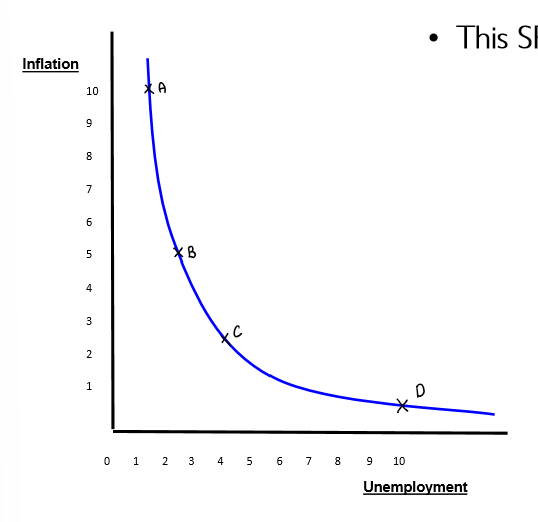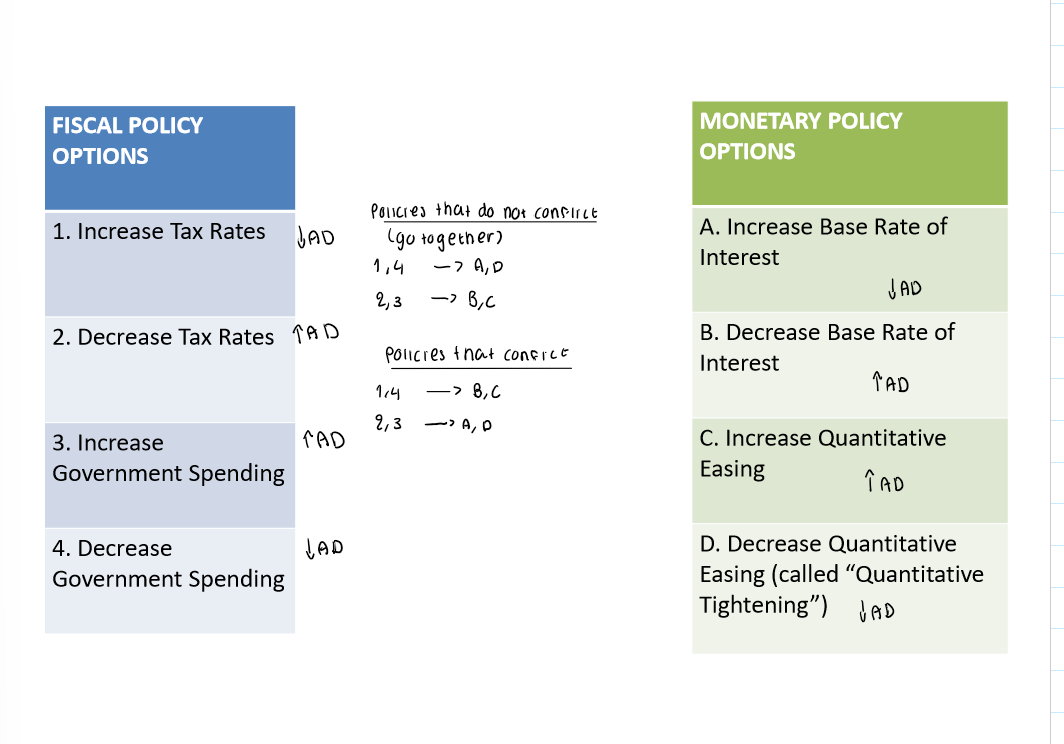2.6.4 Conflicts & trade-offs between objectives and policies
1/6
There's no tags or description
Looks like no tags are added yet.
Name | Mastery | Learn | Test | Matching | Spaced |
|---|
No study sessions yet.
7 Terms
Potential conflicts & trade-offs between the macroeconomic objectives
(trade-offs = when an objective is achieved only at the expense of some other objective)
The main idea is that by improving 1 macroeconomic objective, may worsen another
Conflict: improving economic growth may affect other objectives
1) affect environment
GDP increases → income increases → demand for production increases → more resource exploitation + pollution
2) affect balancing the current account
GDP increases → income increases → increase in import → decreasing current account balance → may lead to current account deficit
3) affect inequality
GDP increases → more profits for business returning to the owner of factors of production due to higher production and sales & workers wages rise
workers wages rise due to increase in production that causes demand for labour to increase - if many firms want workers at the same time, competition increases pushing up worker wages to attract them
But worker’s wages rise not as fast as profits → inequality
Conflict: reducing government borrowing → lower economic growth
In order to still ‘survive’ although borrow less is by doing these 2 ways:
1) Cut government spending → AD decreases → GDP decreases
2) Increase tax so more tax revenue
However
Increase direct tax → tax on income increases → less disposable income → less spending on g/s → less consumption → AD decreases → GDP growth decreases
Increase indirect tax (ie VAT) → firms have less profit → less incentivised to invest → investment decreases → AD decreases → GDP growth decreases
EVAL: why this conflict might not happen
If the reduction in government borrowing shows reliability, credibility, responsibility → firms have more trust that future taxes won’t rise as it seems like the government will be able to manage its finances responsibly → increases business confidence to still invest / consumer confidence to spend as their income will not be affected by tax → GDP may not decrease
Conflict: Improving environment → lower economic growth
1) Firms are forced to meet CO2 restrictions by decreasing production (ie. fines / carbon tax) → cost of production increases → SRAS decreases → GDP decreases
2) Government need to invest money into regulating CO2 emissions → taxation increases → consumption/investment decreases → AD decreases → GDP decreases
EVAL:
1) Firms not having to decrease production due to green industries having an incentive to produce green energy (ie. wind energy, light energy) → level of production can still be maintained
2) Government investment increases → investment in better quality infrastructure → firms can transport more raw materials efficiently & cheaply → decrease cost of production → SRAS increases → GDP increases
Conflict: reduce government borrowing → increase inequality
Cut spending → less government spending on benefits → poor people gets less benefits (ie. unemployment benefit, disability benefit, universal credit = support ppl with low wages)
defence spending is often protected from being cut → other areas of spending are cut instead (ie. welfare benefits, education) → affect low-income
EVAL:
Taxation increases → richer ppl pay more tax → less inequality
Conflict: low unemployment → high inflation (or vice versa) - can be explained by the Short Run Philips Curve
low unemployment → high inflation
1) Low unemployment often occurs in a boom
2) More income → more disposable income → consumption increases → AD increases → demand pull inflation
3) Also, there is an increase in demand for production during this period → firms need new workers → need to pay high wages to attract them → cost of production increases → cost-push inflation
4) Due to demand pull inflation + cost-push inflation → low rates of unemployment may cause high inflation
High unemployment → low inflation
1) high unemployment often occurs in a recession
2) lower income → less disposable income → consumption decreases → AD decreases → demand pull inflation decreases
3) Also, due to high unemployment, workers can pay low wages to get them due to surplus of labour → cost of production decreases → cost-push inflation decreases
4) Due to lower demand pull inflation + lower cost-push inflation → high rate of unemployment may cause low inflation
Government tries to be at point C: inflation rate at around 3%, unemployment rate around 4% - ie.

Policy conflicts & trade offs: How to make sure one macroeconomic policy doesn’t cancel out another (doesn’t conflict each other)
Demand-side policies can either be expansionary (AD increases) / contractionary (AD decreases)
If Government fiscal policy is expansionary, Central Bank monetary policy should too to prevent the effects from cancelling each other out (same for contractionary)
